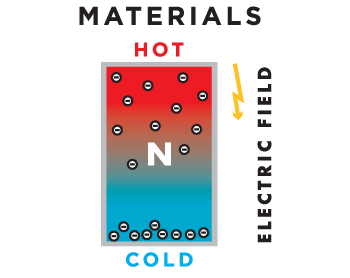Today (February 22, 1785) is the Birthday of Jean Charles Athanase Peltier, who discovered the Peltier effect when current flows.
Jean Charles Athanase Peltier was born on 22 February 1785 in Ham, France. Peltier initially trained as a watchmaker and was up to his 30s working as a watch dealer. Peltier worked with Abraham Louis Breguet in Paris. Later, he worked with various experiments on electrodynamics and noticed that in an electronic element when current flows through, a temperature gradient or temperature difference is generated at a current flow. In 1836 he published his work and in 1838 his findings were confirmed by Emil Lenz. Furthermore, Peltier dealt with topics from atmospheric electricity and meteorology. In 1840, he published a work on the causes and formation of hurricanes.
Peltier's numerous papers are devoted in great part to atmospheric electricity, waterspouts, cystometry and polarization of sky-light, the temperature of water in the spheroidal state, and the boiling-point at great elevations. There are also a few devoted to curious points of natural history. But his name will always be associated with the thermal effects at junctions in a voltaic circuit, a discovery of importance quite comparable with those of Seebeck and Cumming. Peltier discovered the calorific effect of electric current passing through the junction of two different metals. This is now called the Peltier effect ( Peltier–Seebeck effect). By switching the direction of the current, either heating or cooling may be achieved. Junctions always come in pairs, as the two different metals are joined at two points. Thus heat will be moved from one junction to the other.


The Peltier effect is the presence of heating or cooling at an electrified junction of two different conductors (1834). His great experimental discovery was the heating or cooling of the junctions in a heterogeneous circuit of metals according to the direction in which an electric current is made to pass around the circuit. This reversible effect is proportional directly to the strength of the current, not to its square, as is the irreversible generation of heat due to resistance in all parts of the circuit. It is found that, if a current pass from an external source through a circuit of two metals, it cools one junction and heats the other. It cools the junction if it is in the same direction as the thermoelectric current which would be caused by directly heating that junction. In other words, the passage of a current from an external source produces in the junctions of the circuit a distribution of temperature which leads to the weakening of the current by the superposition of a thermo-electric current running in the opposite direction.



When electromotive current is made to flow through an electronic junction between two conductors, heat is removed at the junction. To make a typical pump, multiple junctions are created between two plates. One side heats and the other side cools. A dissipation device is attached to the hot side to maintain the cooling effect on the cold side. Typically, the use of the Peltier effect as a heat pump device involves multiple junctions in series, through which a current is driven. Some of the junctions lose heat due to the Peltier effect, while others gain heat. Thermoelectric pumps exploit this phenomenon, as do thermoelectric cooling Peltier modules found in refrigerators. The Peltier effect can be considered as the back-action counterpart to the Seebeck effect (analogous to the back-emf in magnetic induction: if a simple thermoelectric circuit is closed then the Seebeck effect will drive a current, which in turn (via the Peltier effect) will always transfer heat from the hot to the cold junction.

The true importance of this "Peltier effect" in the explanation of thermoelectric currents was first clearly pointed out by James Prescott Joule; and Sir William Thomson further extended the subject by showing, both theoretically and experimentally, that there is something closely analogous to the Peltier effect when the heterogeneity is due, not to the difference of quality of matter, but to the difference of temperature in contiguous portions of the same material. Shortly after Peltier's discovery was published, Lenz used the effect to freeze small quantities of water by the cold developed in a bismuth-antimony junction when a voltaic current was passed through the metals in the order named. Jean Charles Athanase Peltier, who discovered the Peltier effect, left the world on October 27, 1845, in Paris, France, in his 60s.
Source By: Wikipedia
Information: Dr. P. Ramesh, Assistant Professor of Physics, Nehru Memorial College, Puthanampatti, Trichy.
Get information like this
https://t.me/joinchat/jpqj3jQLN51kYTk9
Join Telegram Group.
https://chat.whatsapp.com/FisIzCe4Br2CRgxAiicUnf
Join WhatsApp Group
Thanks.
Also, Read
🛑👍 CSIR-NET Physics Materials and Problems
🛑📕 21 GB and Hundreds of Physics E-Books Collection.
🛑🛥️ How does an Electric Motor work? (DC Motor).
🛑🤹♂️ Science Academies' Summer Research Fellowship Programme for Students and Teachers 2022.
🛑🔌 How does a Transformer work - Working Principle electrical engineering.
🛑🎙️ Transistors Explained - How transistors work.
🛑🔥⚡ How Thermocouples Work - basic working principle.
🛑🔌 Voltage Explained - What is Voltage? Basic electricity potential difference
🛑🔌 What is CURRENT– electric current explained, electricity basics.





.jpg)
No comments:
Post a Comment